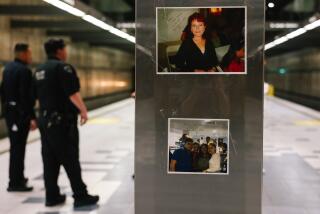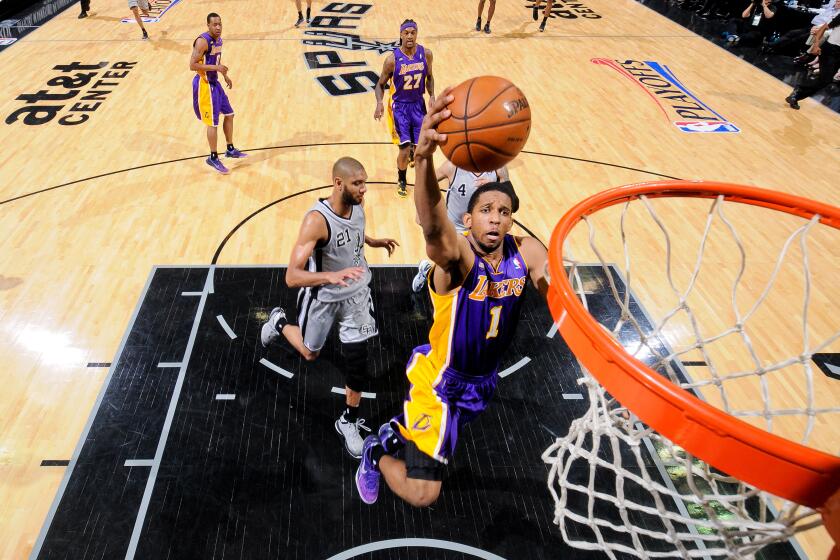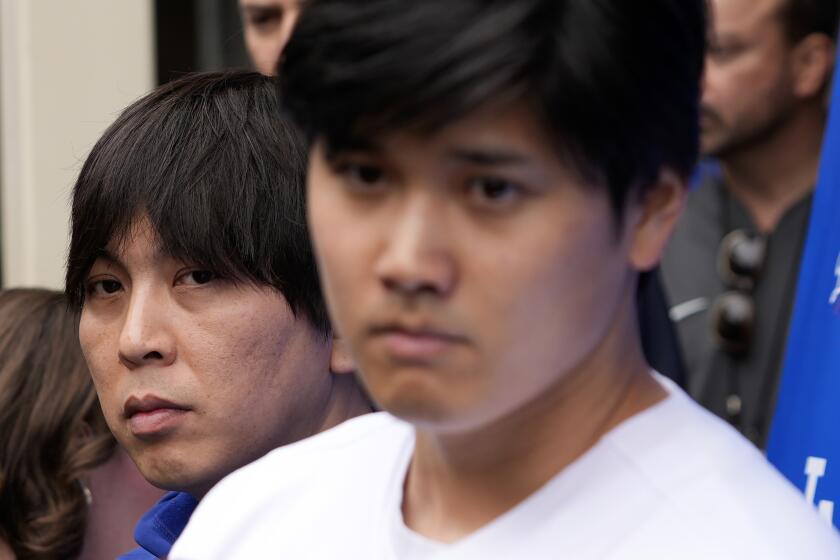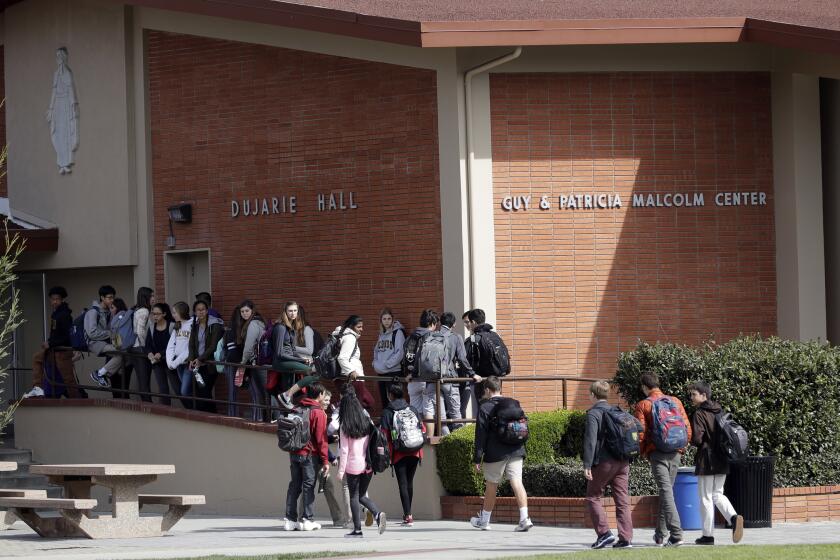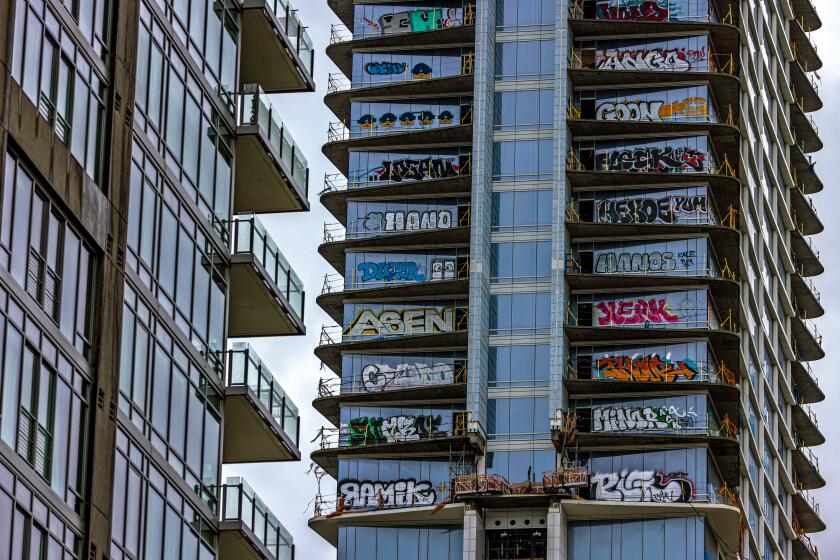A walk on the risky side
You know who you are. You think you’re smart, avoiding the freeways in your daily commute, pulling off onto surface streets, zooming past the low-rise buildings of inner L.A., past liquor stores and street vendors.
The stoplights are timed to keep you going at least 35 mph. But sometimes you see pedestrians with one or two feet inside a crosswalk. Working people, mothers with strollers, kids headed for school. Their lives are in your hands. Yet you zip past; you’re in a big hurry.
“You see what I mean!” Jesse Ledezma, a 47-year-old aerospace worker, screamed in my direction on West Temple Street this week. He was halfway along a crosswalk when a black Infinity SUV swerved past him like a bull rounding a toreador, missing him by about 4 feet.
“I wasn’t lying!” Ledezma shouted. “They don’t stop!”
A few minutes earlier, Ledezma and I had been talking about just how dangerous that crosswalk is.
At 7:50 a.m. on Sept. 27, three of Abelina Maceda’s daughters ventured to cross there.
Maceda, a 36-year-old single mom, had left at 6 a.m. for her job at a cleaning company, leaving her two youngest in the care of their 16-year-old sister, Saira. Saira was walking the girls to Plasencia Elementary.
They crossed three of four lanes safely. But as they approached the curb, they were hit by a 2000 Toyota Celica.
Shaken residents near the intersection with Laveta Terrace told me what happened:
Saira and 10-year-old Chris were tossed about 30 feet, landing in front of a video rental store. Five-year-old Ruby landed inside the crosswalk. The girls’ backpacks and homework were strewn about. Their shoes had been knocked off.
“The smallest one was twisting and turning and screaming horribly,” said Griselda Lopez, 43, a local resident. “She was grabbing her nose. Her face and hair and her sweater were all soaked in blood.”
Being a pedestrian in L.A. is always dangerous. But certain intersections and crosswalks are more lethal than they need to be. That’s because the people who use them are invisible to policymakers who decide how traffic flows through the city.
This crosswalk lies within a few blocks of four public school campuses. In another neighborhood, there might a traffic signal to help pedestrians.
Instead, it’s city policy to transform surface streets like West Temple into “secondary” and “tertiary” routes to and from downtown to alleviate pressure on the Hollywood, 110, 10 and other freeways.
“After 4 the floodgates open, and a tsunami of cars runs over our neighborhoods,” explained Councilman Ed Reyes, who represents the community where the accident took place.
The torrent of cars to and from downtown is deliberately channeled onto thoroughfares in his district — 6th Street, Olympic Boulevard, West Temple. City traffic engineers try to keep rush-hour drivers flowing down those streets as quickly as possible, earning top “A” ratings for these intersections by allowing very little cross traffic.
Reyes said he doesn’t have the votes on the council to change those policies — his densely populated district of working families, with its many immigrants, loses out to better-off suburbs.
So the interests of commuters prevail. Every workday morning, tow trucks and parking cops arrive on West Temple to allow them to go faster. To free up space in the eastbound lanes, parking is prohibited from 7 to 9 a.m. — just when kids are walking to school.
After the girls were hit last week, neighbors rushed to assist them.
Saira, in shock from twobroken arms and twobroken legs, begged Lopez to help her younger sister. “I can’t feel my hand, I can’t move,” Saira told Lopez. A few minutes later, Saira asked Lopez to take her phone and call another, older sister, Diana, who lives nearby.
Two staff members from nearby Plasencia Elementary, where Ruby and Chris go to school, arrived to help. One traveled with Saira in an ambulance to a hospital. Diana, 19, traveled with her sister Ruby to another hospital.
The driver who struck them won’t be charged. She was apparently driving below the 35-mph speed limit, police said, and had a plausible explanation for why she didn’t see the girls: that stretch of Temple Street climbs at a 4% grade, and at 7:50 a.m. the sun rising over Temple blinded her.
“I’ve seen this before,” said Felix Padilla, a detective with the LAPD’s Central Traffic Division, referring to the blinding sun.
Indeed, in 22 years with Central Traffic, he’s seen just about everything. A pedestrian being hit by a car is a daily occurrence. Now, as a detective, he handles two or three cases a year of pedestrians being killed.
“They’re actually very lucky,” Padilla said of the Maceda girls. “Young children have a low center of gravity. Their body mass is lower than an adult. Typically they get sucked under the car. Fortunately we didn’t see that here.”
Saira has had two surgeries and many blood transfusions. On Thursday, she remained hospitalized for her injuries, her mother told me. Ruby was released after a few days’ treatment for facial injuries.
Over at Plasencia Elementary, the children are saying prayers for their stricken classmates and giving an extra, cautious look every time they cross Temple. They’re more aware now that, to certain drivers on that very busy street, children can be invisible, even when they’re standing within the painted white lines of a crosswalk.
It’s up to you, impatient commuter, to open your eyes and see them. And if a crossing light appears on your shortcut one day, give thanks and don’t complain.
More to Read
Start your day right
Sign up for Essential California for news, features and recommendations from the L.A. Times and beyond in your inbox six days a week.
You may occasionally receive promotional content from the Los Angeles Times.
